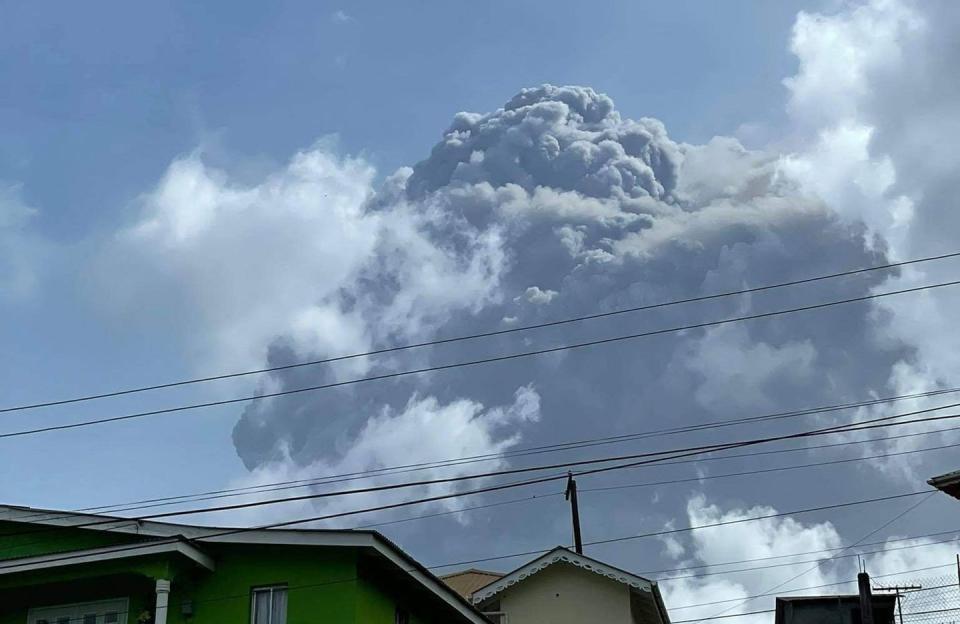Everything We Know About the Volcano Eruption on St. Vincent

On Friday, April 9, La Soufrière, the largest volcano and the highest peak on the main island of St. Vincent and the Grenadines, erupted for the first time in 40 years. The blast sent plumes of ash six miles high, blanketing surrounding communities and creating heavy ashfall. Early this morning, another eruption, the biggest yet, rocked the Caribbean island, in what experts called a "huge explosion" of pyroclastic flows (masses of extremely hot ash, lava, and gases that can move more than 120 miles per hour) that are destroying everything in its path. “Anybody who would have not heeded the evacuation, they need to get out immediately," Erouscilla Joseph, director of the University of the West Indies’ Seismic Research Center, told The Associated Press.

16,000 people were evacuated last week.
Seismologists began noticing increased volcanic activity in La Soufrière in December 2020, prompting government officials to review evacuation plans with residents. On Thursday, April 8, a "red alert" was declared and an evacuation order issued, leading 16,000 people living near the volcano, which is located in the northern region of the island, to seek refuge in shelters. Dozens of people who refused to evacuate last week have had to be rescued by the coast guard.
I have issued an evacuation order to all residents living in the RED ZONES on the North East and the North West of the island. All residents are asked to act accordingly with immediate effect to ensure their safety and that of their families. pic.twitter.com/AJQlCDtOPg
— Ralph Gonsalves (@ComradeRalph) April 8, 2021
This eruption is one of the worst in St. Vincent's history.
While no fatalities or injuries have yet been reported, experts are comparing the magnitude of this event's destruction to La Soufrière's eruption in 1902, which was the country's most catastrophic and killed more than 1,000 people.
Forests, farms, homes, and livestock have been destroyed. Water and food supplies have been cut off in some areas, forcing the government to drill for water and set up distribution points. There has been a massive power outage. Transportation remains treacherous because the smoke is so thick. Emergency personnel have likened the landscape to a "battle zone." White ash has covered homes across the island. Residents of Barbados, 124 miles away, have been told to stay indoors, while those living on St. Lucia, 47 miles away, have been warned of poor air quality and harmful gases. It goes without saying that scores of flights to and from the region, including Barbados, Dominica, St. Lucia, and Antigua, have been canceled.
Countries have offered to help but Covid-19 is complicating evacuation efforts.
Neighboring countries have stepped up to offer aid and financial support. Prime Minister Timothy Harris of St. Kitts and Nevis pledged $1 million in disaster relief. Venezuelan Foreign Minister Jorge Arreaza announced he would send humanitarian supplies. Barbados deployed members of its Defense Force to deliver UNICEF relief supplies and offer assistance. It also joined St. Lucia, Antigua, and Grenada in agreeing to accept evacuees, with empty Carnival and Royal Caribbean cruise ships on standby to transport them.
The pandemic, however, has complicated things. St. Vincent's prime minister Ralph Gonsalves has stated that those wishing to board cruise ships to seek refuge in other countries must be vaccinated before doing so, as the nations accepting St. Vincent's residents will require that they are immunized. "The chief medical officer would be identifying the persons already vaccinated so that we can get them on the ship," he said at a press conference last week. Even some St. Vincent hotels that are being turned into emergency shelters are asking that people be vaccinated. While Covid-19 tests are being administered at government-run shelters, those who turn up positive for the virus will be sent to an isolation center.
You Might Also Like

